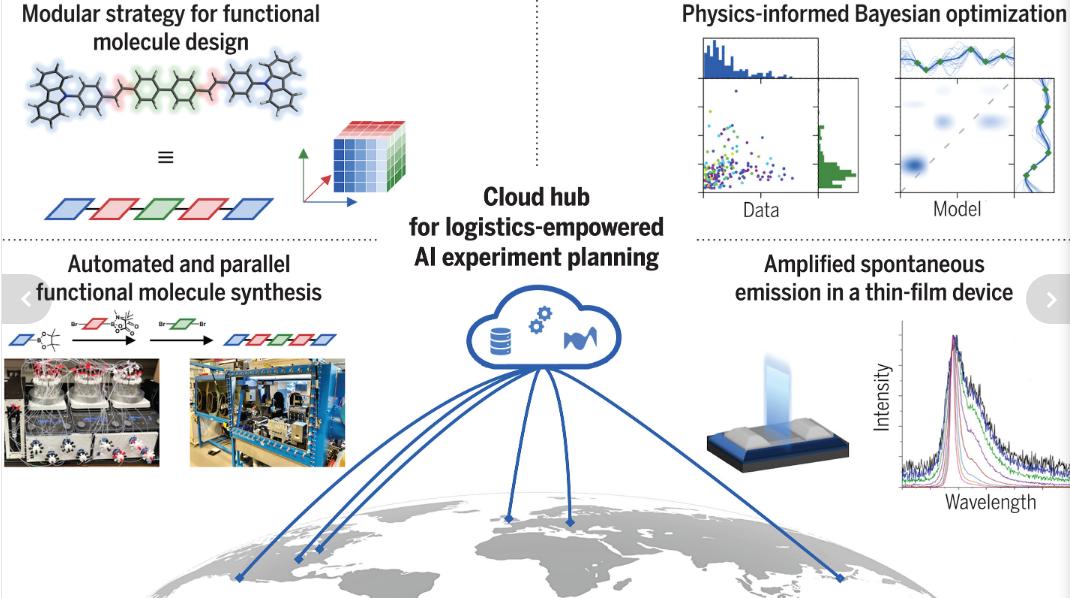博文
全球开创性研究发现21种新型激光材料
 精选
精选
||
全球开创性研究发现21种新型激光材料
诸平
https://scitechdaily.com/21-new-laser-materials-uncovered-in-groundbreaking-global-study/
据加拿大多伦多大学(University Of Toronto, Toronto, ON, Canada.)2024年6月3日提供的消息,全球开创性研究发现21种新型激光材料(21 New Laser Materials Uncovered in Groundbreaking Global Study)。来自全球5个实验室的6个研究团队使用自动驾驶实验室(self-driving labs简称SDL),将材料的发现时间从几年缩短到几个月。
有机固体激光器(Organic solid-state lasers简称OSLs)由于其灵活性,颜色可调性和高效率,为各种应用提供了巨大的潜力。然而,它们的生产具有挑战性。由于可能需要超过15万次实验来确定可行的新材料,完全探索这个空间可能需要许多人的一生。事实上,在过去的几十年里,只有10-20种新的OSL材料被测试过。
多伦多大学加速联盟(Acceleration Consortium, University of Toronto, Toronto, ON, Canada)的研究人员接受了这一挑战,并使用了自动驾驶实验室(SDL)技术,一旦建立起来,他们就能够合成和测试超过1000种潜在的OSL材料,并在几个月内发现至少21种表现最佳的OSL增益候选材料。
SDL使用人工智能和机器人合成(robotic synthesis)等先进技术来简化识别新材料的过程,在这种情况下,材料具有特殊的激光特性。到目前为止,SDLs通常被限制在一个地理位置的物理实验室中。2024年5月17日在《科学》(Science)杂志网站发表的论文——Felix Strieth-Kalthoff, Han Hao, Vandana Rathore, Joshua Derasp, Théophile Gaudin, Nicholas H. Angello, Martin Seifrid, Ekaterina Trushina, Mason Guy, Junliang Liu, Xun Tang, Masashi Mamada, Wesley Wang, Tuul Tsagaantsooj, Cyrille Lavigne, Robert Pollice, Tony C. Wu, Kazuhiro Hotta, Leticia Bodo, Shangyu Li, Mohammad Haddadnia, Agnieszka Wołos, Rafał Roszak, Cher Tian Ser, Carlota Bozal-Ginesta, Riley J. Hickman, Jenya Vestfrid, Andrés Aguilar-Granda, Elena L. Klimareva, Ralph C. Sigerson, Wenduan Hou, Daniel Gahler, Slawomir Lach, Adrian Warzybok, Oleg Borodin, Simon Rohrbach, Benjamin Sanchez-Lengeling, Chihaya Adachi, Bartosz A. Grzybowski, Leroy Cronin, Jason E. Hein, Martin D. Burke, Alán Aspuru-Guzik. Delocalized, asynchronous, closed-loop discovery of organic laser emitters. Science, 2024, 384 (6697): eadk9227. DOI: 10.1126/science.adk9227. Epub 17 May 2024. https://www.science.org/doi/10.1126/science.adk9227. 此文展示了研究团队如何使用分布式实验的概念,在不同的研究地点分配任务,以更快地实现共同目标。
参与此项研究的除了来自加拿大多伦多大学的研究人员之外,还有来自加拿大英属哥伦比亚大学(University of British Columbia, Vancouver, BC, Canada)、加拿大多伦多的向量人工智能研究所(Vector Institute for Artificial Intelligence, Toronto, ON, Canada)、加拿大高级研究所{Canadian Institute for Advanced Research (CIFAR), Toronto, ON, Canada};美国伊利诺伊大学厄巴纳-尚佩恩分校(University of Illinois at Urbana-Champaign, Urbana, IL, USA)、美国北卡罗莱纳州立大学(North Carolina State University, Raleigh, NC, USA)、美国Allchemy公司(Allchemy Inc., Highland, IN, USA)、美国谷歌研究(Google Research, Brain Team, Cambridge, MA, USA);日本九州大学(Kyushu University, Fukuoka, Japan)、日本神奈川的三菱化学株式会社科学与创新中心(Mitsubishi Chemical Corporation Science & Innovation Center, Kanagawa, Japan);波兰科学院有机化学研究所(Institute of Organic Chemistry, Polish Academy of Sciences, Warsaw, Poland)、波兰克拉科夫的雅盖隆大学(Jagiellonian University, Krakow, Poland);韩国蔚山的基础科学研究所(Institute for Basic Science, Ulsan, Republic of Korea)、韩国蔚山的科学技术研究所(Ulsan Institute of Science and Technology, Ulsan, Republic of Korea);英国格拉斯哥大学(University of Glasgow, Glasgow, UK)、西班牙加泰罗尼亚能源研究所(Catalonia Institute for Energy Research, Barcelona, Spain)以及挪威卑尔根大学(University of Bergen, Bergen, Norway)的研究人员。
分布式实验的好处(Benefits of Distributed Experimentation)
通过使用这种方法,每个实验室都能够贡献其独特的专业知识和资源,这最终在项目的成功中发挥了关键作用。这种分散的工作流程由基于云的平台管理,不仅提高了效率,而且允许快速复制实验结果,最终使发现过程民主化,并加速下一代激光技术的发展。
加速联盟主任艾伦.阿斯普鲁.古济克(Alán Aspuru-Guzik)博士说:“这篇论文表明,闭环方法可以非局部化,研究人员可以从分子状态一直到设备,你可以加速发现处于商业化过程早期的材料。该团队设计了一个从分子到设备的实验——最终的设备是在日本制造的。它们在加拿大温哥华被放大,然后被转移到日本进行鉴定。”
这些新材料的发现代表了分子光电子学(molecular optoelectronics)领域的重大进展。它为提高OSL设备的性能和功能铺平了道路,并为材料科学和自动驾驶实验室领域未来的非本地化发现活动树立了先例。
上述介绍,仅供参考。欲了解更多信息,敬请注意浏览原文或者相关报道。
Recent advances in experimental automation and integration with artificial intelligence (AI) have laid the foundation for so-called “self-driving labs,” but in most cases they remained limited to simple proof-of-concept experiments. Strieth-Kalthoff et al. presented their concept of asynchronous cloud-based delocalized closed-loop (ACDC) discovery to drive multiple geographically distributed platforms in a single discovery campaign in which each unit operates as an independent, asynchronous worker executing experiments planned by a central AI entity. The ACDC concept has been successfully applied in the search for organic solid-state laser gain materials with state-of-the-art lasing performance, a challenging scientific problem with slow progress, thereby demonstrating the power of this closed-loop campaign. —Yury Suleymanov
Introduction Modern materials discovery necessitates intricate workflows that integrate synthesis, property characterization, formulation, and system-level testing. Often, the required expertise and research infrastructure are dispersed across multiple locations and time zones, which hinders their integration into advanced discovery pipelines. This challenge is particularly pronounced in the context of automated experimentation and data-driven decision-making with artificial intelligence (AI), which usually rely on streamlined flows of data and materials at a single site.
Rationale Synergistically integrating experimental research infrastructure at geographically distributed sites requires a central, globally accessible cloud hub for data transfer; AI-informed experiment design; and logistics management. Such a decentralized engine can effectively orchestrate global design-make-test-analyze loops for materials discovery that would be impractical to establish in a single laboratory.
Results We demonstrate the distributed, AI-guided discovery of best-in-class small-molecule gain materials for organic solid-state lasers (OSLs). To overcome the prevalent synthesis bottleneck in molecular discovery, we devised a building block–based strategy to rapidly construct molecular function. Leveraging iterative Suzuki–Miyaura couplings, we developed a generalizable two-step one-pot protocol for assembling pentameric OSL gain materials from modular precursors, spanning a candidate space of >150,000 target materials. The preparation of building blocks was distributed over the available experimental resources at four geographic locations. Similarly, the assembly of building blocks to form the gain material candidates was parallelized and automated on different robotic synthesis platforms. This multisite synthesis engine was complemented by a resource-efficient, end-to-end automated testing workflow, encompassing (i) purification to a degree that allows for reliable spectroscopic measurements and (ii) solution-phase characterization through steady-state and time-resolved spectroscopy.
The resulting laser-like property data, asynchronously obtained from the different “workers,” fed into the central, machine learning–based experiment planning module hosted on the cloud hub. This module was supplemented with physical knowledge from quantum-chemical simulations and logistic constraints from multisite experimentation. Taking into account what could be done, what was being done, and what had been done at any point in time, the module maintained a ranked catalog of most-informative next experiments—from which the following sets of experiments were allocated to the available robotic platforms at the different sites.
Throughout the development and operation of this multisite discovery engine, we found a total of 21 small-molecule emitters with improved emission gain cross sections compared with state-of-the-art OSL gain materials. For their property evaluation on a device level, on-scale synthesis and purification introduced further challenges, necessitating the development of automated workflows for synthesis with on-line decision-making and purification through continuous preferential crystallization. Ultimately, laser-like properties of three identified materials were measured in thin films, confirming the discovery of gain materials with best-in-class amplified spontaneous emission thresholds.
Conclusion Addressing a frontier challenge in molecular optoelectronics, this work demonstrates a blueprint for decentralized (molecular) discovery in the age of AI. A central, readily accessible hub that manages data transfer, the logistics of materials transport and availability, and the experimental design process has proven to be of central importance. Eventually, we are convinced that scaling such a framework to flexibly include distributed human and robotic research resources can pave the way for democratizing (materials) discovery.
Contemporary materials discovery requires intricate sequences of synthesis, formulation, and characterization that often span multiple locations with specialized expertise or instrumentation. To accelerate these workflows, we present a cloud-based strategy that enabled delocalized and asynchronous design-make-test-analyze cycles. We showcased this approach through the exploration of molecular gain materials for organic solid-state lasers as a frontier application in molecular optoelectronics. Distributed robotic synthesis and in-line property characterization, orchestrated by a cloud-based artificial intelligence experiment planner, resulted in the discovery of 21 new state-of-the-art materials. Gram-scale synthesis ultimately allowed for the verification of best-in-class stimulated emission in a thin-film device. Demonstrating the asynchronous integration of five laboratories across the globe, this workflow provides a blueprint for delocalizing—and democratizing—scientific discovery.
https://wap.sciencenet.cn/blog-212210-1437034.html
上一篇:20年的难题解决了:物理学家揭示了零维铁电体的三维漩涡
下一篇:新的成本效益计划可以减少20%的二氧化碳排放,然而,它仍然需要花费数十亿美元

